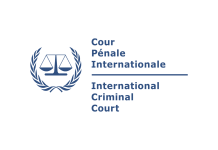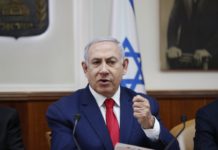TEL AVIV, Israel (AP) — President Donald Trump opened his first visit to Israel Monday, an early visit by a president to a longtime Middle East ally and one aimed at testing the waters for jumpstarting the region’s dormant peace process.
Trump flew in from Saudi Arabia, where he basked in a lavish welcome from the kingdom’s royal family, and received a similarly warm welcome in Tel Aviv. In brief remarks during an airport ceremony, the president said he had come “to reaffirm the unbreakable bond between the United States and the state of Israel” and that his visit with Arab leaders gave him “new hope” for peace in the region.
President Donald Trump landed at at Ben-Gurion International Airport on Monday for a two-day visit to Israel and the Palestinian territories. The President’s flight was believed to be the first direct flight between Saudi Arabia and Israel. (May 22).
“We have before us a rare opportunity to bring security and stability and peace to this region and to its people,” Trump said.
Trump received a warm welcome in Tel Aviv after becoming the first U.S. president to include Israel on his maiden overseas trip. Israeli Prime Minister Benjamin Netanyahu called Trump “a true friend” to Israel and sounded hopeful notes about the president’s role in the Middle East peace process.
But Trump may face questions from Israeli officials about revelations that he disclosed sensitive Israeli intelligence to Russian officials and concerns over the new $110 billion arms deal he announced with the Saudis. U.S. Secretary of State Rex Tillerson, speaking to reporters on Air Force One, said the U.S. could provide clarifications to Israel about what happened but said, “I don’t know that there’s anything to apologize for.”
Before meetings Monday with Netanyahu, the president and first lady Melania Trump will visit the Western Wall, an important Jewish holy site, and the Church of the Holy Sepulchre, which is believed to be where Jesus was crucified and the location of his tomb.
On Tuesday, Trump will meet with Palestinian Authority President Mahmoud Abbas. After hosting Abbas at the White House in March, Trump boldly stated that achieving peace is “something that I think is, frankly, maybe not as difficult as people have thought over the years.”
“But we need two willing parties,” he said. “We believe Israel is willing. We believe you’re willing. And if you both are willing, we’re going to make a deal.”
White House aides have tried to play down expectations for significant progress on the peace process during Trump’s stop, casting it as more symbolic than substantive. Tillerson referred to the visit as “a moment in time” and suggested that the U.S. would take a more active role in the future in brokering a deal if both sides make serious commitments.
Trump made one symbolic gesture Monday in bridging the gap between Israel and the Arab world. His flight on Air Force One was believed to be the first direct flight between Saudi Arabia and Israel, nations that do not have diplomatic relations. Netanyahu said he hoped an Israeli prime minister could soon make the same flight.
While Israeli officials cheered Trump’s election, some are now wary of the tougher line he has taken on settlements: urging restraint but not calling for a full halt to construction. Trump has also retreated from a campaign pledge to move the U.S. Embassy in Israel from Tel Aviv to Jerusalem, bending to the same diplomatic and security concerns as other presidents who have made similar promises.
Palestinians, who viewed Trump’s victory with some trepidation, are said to have been pleasantly surprised by Trump’s openness during a recent meeting with Abbas in Washington.
And on the eve of Trump’s visit, an Israeli official said Netanyahu’s cabinet has approved confidence building measures with the Palestinians, including allowing building in a West Bank area. The official briefed on Sunday’s meeting said the package includes building permits for Palestinians in Area C that has largely been off limits to Palestinian development until now. He spoke on condition of anonymity pending a formal government announcement. He did not elaborate and it is not clear how big the plan is.
One point of contention in the talks: the fate of east Jerusalem, which Israel captured in the 1967 Mideast war. The area is home to sensitive religious sites, including the Western Wall, the holiest place where Jews can pray.
Israel considers the entire city to be its capital while the international community says the future of east Jerusalem, claimed by the Palestinians, must be resolved through negotiations. The Trump administration drew the ire of some Israelis this week when officials declined to state that the Western Wall was part of Israel, as has been U.S. policy.
Israeli officials say they are largely in the dark about what ideas Trump might present for peace or what concessions he may demand. And while Netanyahu in the past has expressed support for the establishment of a Palestinian state, he has been vague about this goal since Trump gained power.
Meanwhile, Palestinian activists are calling for a “Day of Rage” when Trump visits the West Bank on Tuesday. The demonstrations are meant to draw attention to a month-long hunger strike by hundreds of prisoners being held by Israel and to protest what many Palestinians say is unfair U.S. support for Israel.
Trump’s two day visit in Israel follows two days in in Saudi Arabia, home to Islam’s holiest sites, where Trump brokered the arms contract while also trying to strengthen relations with other Arab nations. He also delivered a closely watched speech to the Muslim world in which he called for Middle East leaders to root out extremists at home, while casting the fight against terror as “good vs. evil” rather than the West vs. Islam. In a pointed departure from his predecessor, Trump all but promised he would not publicly admonish Mideast rulers for human rights violations and oppressive reigns.
Iran’s foreign minister accused Trump of using foreign policy as an excuse for selling billions of dollars’ worth of weapons to Saudi Arabia, its longtime foe.














